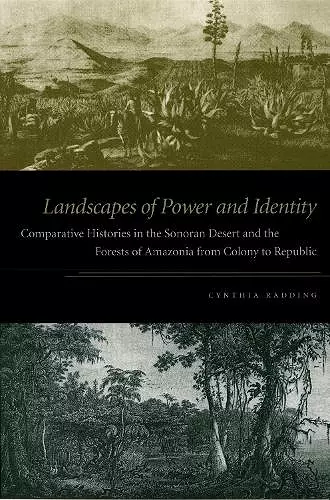Landscapes of Power and Identity
Comparative Histories in the Sonoran Desert and the Forests of Amazonia from Colony to Republic
Format:Paperback
Publisher:Duke University Press
Published:18th Jan '06
Currently unavailable, and unfortunately no date known when it will be back

This comparative frontier history explores the role that natural environments played in shaping the contours of European-indigenous encounters and processes of colonization
Landscapes of Power and Identity is a groundbreaking comparative history of two colonies on the frontiers of the Spanish empire—the Sonora region of northwestern Mexico and the Chiquitos region of eastern Bolivia’s lowlands—from the late colonial period through the middle of the nineteenth century. An innovative combination of environmental and cultural history, this book reflects Cynthia Radding’s more than two decades of research on Mexico and Bolivia and her consideration of the relationships between human societies and the geographic landscapes they inhabit and create. At first glance, Sonora and Chiquitos are quite different: one a scrub-covered desert, the other a tropical rainforest of the greater Amazonian and Paraguayan river basins. Yet the regions are similar in many ways. Both were located far from the centers of colonial authority, organized into Jesuit missions and linked to the principal mining centers of New Spain and the Andes, and then absorbed into nation-states in the nineteenth century. In each area, the indigenous communities encountered European governors, missionaries, slave hunters, merchants, miners, and ranchers.
Radding’s comparative approach illuminates what happened when similar institutions of imperial governance, commerce, and religion were planted in different physical and cultural environments. She draws on archival documents, published reports by missionaries and travelers, and previous histories as well as ecological studies and ethnographies. She also considers cultural artifacts, including archaeological remains, architecture, liturgical music, and religious dances. Radding demonstrates how colonial encounters were conditioned by both the local landscape and cultural expectations; how the colonizers and colonized understood notions of territory and property; how religion formed the cultural practices and historical memories of the Sonoran and Chiquitano peoples; and how the conflict between the indigenous communities and the surrounding creole societies developed in new directions well into the nineteenth century.
“There has been much talk about comparative history but precious little of it in the Spanish colonial period. Cynthia Radding has led the way.”— David J. Weber, Director of the William P. Clements Center for Southwest Studies, Southern Methodist University
“This is a beautifully written comparative frontier history that balances in-depth historical analysis of two relatively unexplored regions on the edge of the Spanish empire against broader insights into the active role that ecologies played in shaping the contours of European-indigenous encounters and processes of colonization over long periods of time. With this book, Cynthia Radding takes the ‘new environmental history’ of conquest and colonization to a new level.”—Brooke Larson, author of Trials of Nation Making: Liberalism, Race, and Ethnicity in the Andes, 1810-1910
“Carefully researched and clearly written, Landscapes of Power and Identity provides an illuminating comparison of the environmental history of Spanish colonialism. . . . Landscapes of Power and Identity will be an illuminating read for specialists in a variety of fields including environmental history, borderlands history, and Spanish colonial history and a model for all those scholars interested in pursuing comparative history.” -- Rachel St. John * Western Historical Quarterly *
ISBN: 9780822336891
Dimensions: unknown
Weight: 653g
456 pages